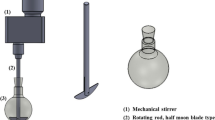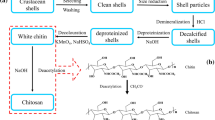Abstract
The dynamic adsorption and desorption behaviors of rosin colloids onto and from CNFs and TOCNFs in aqueous media were investigated using QCM-D measurements. Gum rosin colloids (GR-C) were well adsorbed onto CNFs, but not well adsorbed onto TOCNFs. Maleic anhydride modification of GR had little effect on the surface charge but contributed to particle size reduction, an increase in the glass transition temperature (Tg) and an enhancement of the colloids’ stability. The adsorption of GR–maleic anhydride adducts colloids (GRM-C) was not affected by the surface charge of the cellulose nanofibers in the aluminum sulfate (Alum)-free system, but was significantly affected by that in the Alum-containing system. Maleic anhydride modification contributed to an increase in the adsorption rate of the rosin colloids in the system of CNFs with Alum. On the other hand, using an anionic surfactant contributed to increasing the particle size and ionicity of the rosin colloids. The adsorption of GR–maleic anhydride adducts with anionic surfactant colloids (GRMS-C) was higher than that of GRM-C in the system of CNFs with and without Alum, suggesting that using an anionic surfactant contributed to increasing the adsorption of the rosin colloids onto CNFs. By contrast, GRMS-C was not entirely adsorbed on TOCNFs in the Alum-free system but was adsorbed in the Alum-containing system. The adsorption and desorption behaviors of GRMS-C was also affected by the pH of GRMS-C solution. Thus, dynamic adsorption and desorption behaviors of rosin colloids onto and from cellulose fibers are complicated and influenced by the rosin modification method, using an anionic surfactant or Alum addition.





Similar content being viewed by others
References
Ahola S, Österberg M, Laine J (2008) Cellulose nanofibrils-adsorption with poly(amideamine) epichlorohydrin studied by QCM-D and application as a paper strength additive. Cellulose 15:303–314
Aruga S, Teramoto Y, Takano T (2023) Dissolution behavior of abietic acid in water from the matrices of cellulose nanofibers. Cellulose. https://doi.org/10.1007/s10570-023-05448-6
Bicu I, Mustata F (1996) Crosslinked polymers from rosin acids. Die Angewandte Makromolekulare Chemie 234:91–102
Gagliano G, Gargano M, Pagano P, Sabatino L, Scordino M, Traulo P (2008) Liquid chromatography-negative ion electrospray mass spectrometry detection of maleic anhydride-modified wood rosin for assessing quality of commercial citrus fruit coatings. Eur Food Res Technol 226:991–999
Goto S, Isogai A (2007) Studies on the cofactor/PEO flocculation systems: In situ structural and viscoelastic analyses of cofactor/PEO complexes by QCM-D. Nord Pulp Pap Res J 22(2):155–160
Hänninen T, Orelma H, Laine J (2015) TEMPO oxidized cellulose thin films analyzed by QCM-D and AFM. Cellulose 22:165–171
Hubbe MA (2007) Paper’s resistance to wetting–a review of internal sizing chemicals and their effects. BioResources 2(1):106–145
Kitaoka T, Isogai A (2003) Roles of aluminum sulfate in rosing sizing. SEN-I Gakkaishi 59(9):353–357
Kitaoka T, Isogai A, Onabe F (2000) Rosin sizing of pulps modified by TEMPO-mediated oxidation. Nord Pulp Pap Res J 15(3):177–182
Kugler S, Ossowicz P, Malarczyk-Matsusiak K, Wierzbicka E (2019) Advances in rosin-based chemicals: the latest recipes. Appl Future Trends Mol 24(9):1651. https://doi.org/10.3390/molecules24091651
Kumagai A, Iwamoto S, Lee SH, Endo T (2014) Quartz crystal microbalance with dissipation monitoring of the enzymatic hydrolysis of steam-treated lignocellulosic nanofibrils. Cellulose 21:2433–2444
Mahendra V (2018) Rosin product review. Appl Mech Mater 890:77–91
Marx KA (2003) Quartz crystal microbalance: a useful crystal microbalance: a useful tool for studying thin polymer films and complex biomolecular systems at the solution-surface interface. Biomacromol 4(5):1099–1120
Miao Q, Huang L, Chen L (2013) Advances in the control of dissolved and colloidal substances present in papermaking processes: a brief review. BioResources 8:1431–1455
Mirone P, Chiorboli P (1962) Infrared and Raman spectra and vibrational assignment of maleic anhydride. Spectrochim Acta 18:1425–1432
Nitzman AF, Reeves JD (2009) Synthetic resins in casein-stabilized rosin size emulsions. US Patent 2009(0298975):A1
Saito T, Isogai A (2004) TEMPO-mediated oxidation of native cellulose. The effect of oxidation conditions on chemical and crystal structures of the water-insoluble fractions. Biomacromol 5:1983–1989
Strand A, Khakalo A, Kouko J, Oksanen A, Ketola A, Salminen K, Rojas O, Retulainen E, Shundberg A (2017) The effect of chemical additives on the strength, stiffness and elongation potential of paper. Nord Pulp Pap Res J 32(3):324–335
Strazdins E (1977) Mechanics aspects of rosin sizing. Tappi 60(10):102–105
Tammelin T, Saarinen T, Ȍsterberg M, Lanie J (2006) Preparation of Langmuir/Blodgett surfaces by using horizontal dipping procedure. Application for polyelectrolyte adsorption studies performed with QCM-D. Cellulose 13:519–535
Tammelin T, Johnsen IA, Österberg M, Laine J (2007) Adsorption of colloidal extractives and dissolved hemicelluloses on thermomechanical pulp fiber components studied by QCM-D. Nord Pulp Pap Res J 22:93–101
Tham YY, Molino PJ, Higgins MJ, Stack KR, Richardson DE, Lewis TW (2016) The study of deposition of wood extractives and model compound colloids onto chromium and cellulose surfaces using quartz crystal microbalance with dissipation (QCM-D). Colloids Surf a: Physicochem Eng Asp 491:1–11
Wilbon PA, Chu F, Tang C (2013) Progress in renewable polymers from natural terpenes, terpenoids and rosin. Macromol Rapid Commun 34:8–37
Yang M, Chen X, Li J, Lin H, Zhang S, Han C (2018) Preparation of wood with better water-resistance properties by a one-step impregnation of maleic rosin. J Adhes Sci Technol 32(21):2381–2393
Acknowledgments
The authors acknowledge Dr. Akio Kumagai (Research Institute for Sustainable Chemistry, Department of Materials and Chemistry, National Institute of Advanced Industrial Science and Technology, Japan) for advice on the preparation of CNF- and TOCNF-coated QCM-D gold sensors.
Funding
Not applicable.
Author information
Authors and Affiliations
Contributions
TT, YT and SA designed this study. GRM with anionic surfactant colloids (GRMS-C) solution was prepared by KT and other preparation, characterization and evaluation of the adsorption and desorption behaviors of rosin colloids in aqueous media were performed by SA. The manuscript was written by TT and SA. All authors read and approved the final manuscript.
Corresponding author
Ethics declarations
Competing interests
The authors declare no competing interests.
Human and animal rights
Not applicable.
Additional information
Publisher's Note
Springer Nature remains neutral with regard to jurisdictional claims in published maps and institutional affiliations.
Supplementary Information
Below is the link to the electronic supplementary material.
Rights and permissions
Springer Nature or its licensor (e.g. a society or other partner) holds exclusive rights to this article under a publishing agreement with the author(s) or other rightsholder(s); author self-archiving of the accepted manuscript version of this article is solely governed by the terms of such publishing agreement and applicable law.
About this article
Cite this article
Aruga, S., Takagi, K., Teramoto, Y. et al. Dynamic adsorption and desorption behaviors of rosin colloids onto and from cellulose nanofibers in aqueous media. Cellulose 31, 309–320 (2024). https://doi.org/10.1007/s10570-023-05633-7
Received:
Accepted:
Published:
Issue Date:
DOI: https://doi.org/10.1007/s10570-023-05633-7




